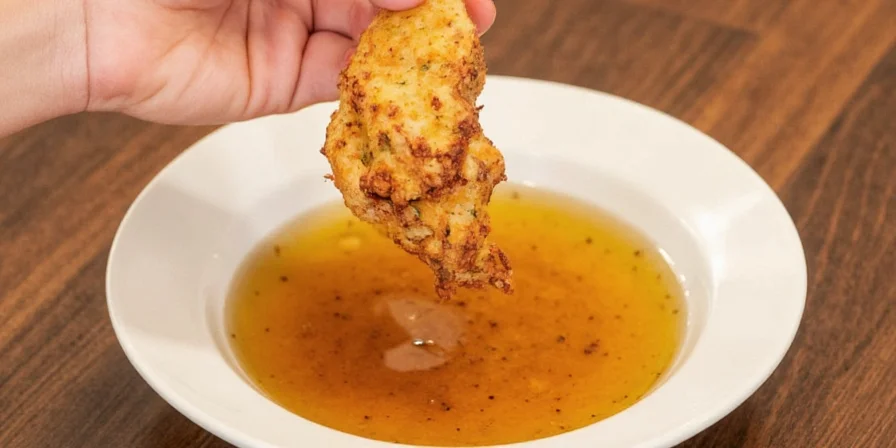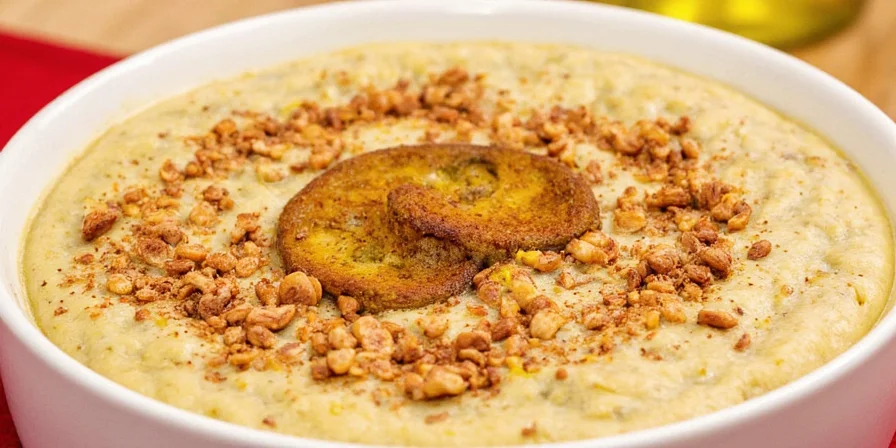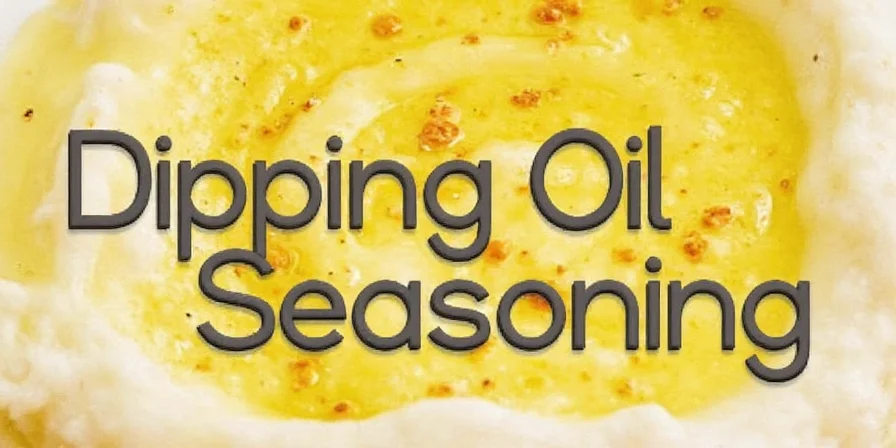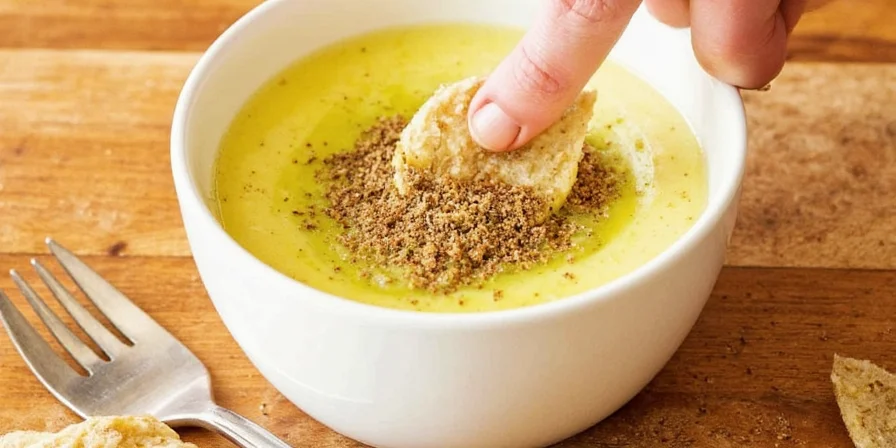Dipping oil seasoning is a carefully balanced blend of high-quality oil and complementary spices that transforms simple bread dipping into a culinary experience. The perfect ratio is 1 cup oil to 1-2 teaspoons of dried spices (1.5 tsp for olive oil with rosemary and red pepper flakes), with critical food safety protocols: always add 1 tbsp lemon juice per cup when using fresh ingredients like garlic to prevent botulism risk, and refrigerate fresh-infused oils for no longer than 7 days.
This guide delivers precisely what home cooks need: actionable ratios, verified safety protocols, and restaurant-quality techniques that solve common problems like cloudy oil and flavor imbalance. Forget vague suggestions—we provide exact measurements, storage timelines, and pairing science backed by food safety standards.
What Is Dipping Oil Seasoning and Why It Matters
Dipping oil seasoning transforms basic oil into a flavor vehicle through precise spice-to-oil ratios and proper infusion techniques. Unlike generic "dump and stir" methods, professional results require understanding three critical elements: oil selection chemistry, spice activation methods, and mandatory food safety protocols.

| Spice Type | Optimal Ratio (per 1 cup oil) | Safety Requirement |
|---|---|---|
| Dried herbs (rosemary, oregano) | 1-1.5 tsp | Room temperature storage: 4 weeks |
| Fresh garlic/herbs | 2-3 cloves or sprigs | Must add 1 tbsp acid + refrigerate ≤7 days |
| Spice blends (za'atar, dukkah) | 1.5-2 tsp | Room temperature storage: 3 weeks |
Immediate Safety Protocol: Botulism Prevention
Garlic and fresh herbs in oil create ideal conditions for botulism toxin production. The CDC requires these safety steps:
- Always add acid (1 tbsp lemon juice or vinegar per cup oil) to fresh-infused oils
- Refrigerate immediately after preparation
- Discard after 7 days—no exceptions
- Never use wet utensils (water introduces spoilage bacteria)

Exact Ratios for Perfect Dipping Oil Every Time
Professional kitchens use these precise measurements. Deviations cause flavor imbalance or safety risks:
| Oil Base | Signature Blend | Precise Ratio | Max Shelf Life |
|---|---|---|---|
| Extra virgin olive oil | Mediterranean classic | 1 cup + 1 tsp dried rosemary + ½ tsp red pepper flakes + 1 crushed garlic clove* | 7 days refrigerated* |
| Avocado oil | California citrus | 1 cup + 1 tsp smoked paprika + 1 tbsp lime zest + ½ tsp black pepper | 4 weeks room temp |
| Toasted sesame oil | Asian fusion | ¼ cup sesame + ¾ cup neutral oil + 1 tsp ginger + 1 tbsp sesame seeds + ½ tsp chili flakes | 3 weeks room temp |
*Must include 1 tbsp lemon juice and refrigerate due to garlic content
Why Store-Bought Options Fail (and How to Fix Them)
Commercial dipping oils often contain preservatives that mute flavor and use imbalanced ratios. Recreate restaurant-quality versions at home with these adjustments to common store-bought bases:
| Common Problem | Professional Fix | Time Required |
|---|---|---|
| Flat, one-dimensional flavor | Add ¼ tsp toasted fennel seeds + 1 strip citrus zest | 2 minutes |
| Overpowering vinegar taste | Dilute with ¼ cup fresh oil + 1 tsp honey | 1 minute |
| Cloudy appearance | Strain through coffee filter + add 1 tbsp neutral oil | 10 minutes |
Critical Storage Guidelines by Ingredient Type
Shelf life varies dramatically based on components. These FDA-aligned timelines prevent foodborne illness:
- Dried spices only: 4 weeks at room temperature in dark glass
- Fresh garlic/herbs: 7 days maximum refrigerated with acid added
- Citrus zest: 2 weeks refrigerated (avoid white pith to prevent cloudiness)
- Nut oils: 2 weeks refrigerated (prone to rancidity)
- Always discard if: Cloudiness, bubbling, off smells, or visible mold
Top 5 Regional Variations with Authentic Ratios
Authentic regional blends follow specific ratios developed through culinary tradition:
- Tuscan (Italy): 1 cup olive oil + 1.5 tsp crushed rosemary + 1 tsp fennel pollen + 2 garlic cloves* (with 1 tbsp lemon juice)
- Levantine (Za'atar): 1 cup olive oil + 2 tsp za'atar blend + ½ tsp sumac + 1 tbsp dried mint
- California Citrus: 1 cup avocado oil + 1 tsp lemon pepper + 2 tbsp orange zest + ½ tsp crushed coriander
- Tokyo Ponzu: ¾ cup neutral oil + ¼ cup citrus-kombu broth + 1 tsp yuzu zest + ½ tsp sansho pepper
- Mexican Adobo: 1 cup olive oil + 1 tbsp smoked paprika + 1 tsp cumin + 1 dried guajillo pepper (stemmed)

Frequently Asked Questions
How long can I safely store homemade dipping oil?
Dried-spice oils last 4 weeks at room temperature in dark containers. Garlic or herb-infused oils require refrigeration and must be used within 7 days due to botulism risks. Always add acid (le tbsp lemon juice per cup) to fresh-infused oils.
Why does my infused oil turn cloudy?
Cloudiness typically indicates moisture contamination. Ensure all ingredients are completely dry before infusion. Citrus zest should avoid white pith, which releases compounds causing cloudiness. Strain through coffee filter and add 1 tbsp fresh neutral oil to correct.
Can I reuse dipping oil after serving?
No. Once oil contacts food (bread, vegetables), it can harbor bacteria. Discard used oil immediately. Never pour leftovers back into storage containers—this introduces moisture and bacteria causing rapid spoilage.
What oil has the longest shelf life for infusions?
High-oleic sunflower or avocado oil lasts longest due to oxidative stability (4 weeks room temperature). Avoid flaxseed or walnut oils which turn rancid quickly. Always refrigerate nut-based infusions and use within 2 weeks.
Proven Pairing Guide: Match Oils to Foods Perfectly
Professional chefs follow these pairing principles based on flavor chemistry:
| Food Item | Optimal Oil Blend | Scientific Reasoning |
|---|---|---|
| Crusty artisan bread | Rosemary-garlic with red pepper flakes | Umami compounds in garlic complement Maillard reaction in bread crust |
| Raw vegetable crudité | Lemon-dill with black pepper | Acidity cuts through vegetable bitterness while enhancing natural sugars |
| Grilled seafood | Fennel-anise with citrus zest | Compounds mimic oceanic flavors while neutralizing fishy odors |
| Fresh tomato slices | Basil-oregano with balsamic reduction | Phenolic compounds in herbs enhance lycopene bioavailability |

Advanced Techniques for Flavor Maximization
Master these professional methods to achieve restaurant-quality results:
- Spice Toasting Protocol: Dry-toast whole spices (cumin, coriander) at 300°F for 3-5 minutes before grinding to triple aromatic compound release
- Temperature-Controlled Infusion: Heat oil to 140°F (not exceeding 160°F) with herbs for 20 minutes to optimize flavor extraction without degradation
- Layered Flavor Development: Add dried spices first, citrus zest second, fresh herbs last when creating multi-ingredient blends
- Clarity Preservation: Blanch citrus zest in boiling water for 10 seconds before use to prevent cloudiness from pith compounds











 浙公网安备
33010002000092号
浙公网安备
33010002000092号 浙B2-20120091-4
浙B2-20120091-4